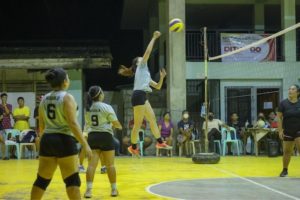Volleyball is a popular and exciting team sport played worldwide.
As you probably already know, volleyball is played with two teams of six players on each team, and the players aim to score points by hitting the ball over a net into another team’s court without touching the floor.

A very important part of the game that people often don’t notice is the rotation system of players. This system determines the order in which order they move around the court.
So, if you want to understand how the game works, it’s vital to understand the rotation system. Why is rotation important in volleyball? How it affects the game exactly? Let’s find out!
Why is Rotation Important in Volleyball: 7 Reasons
Rotation is a fundamental aspect of volleyball that holds significant importance in shaping the dynamics and strategy of the game.
The systematic movement of players across different positions on the court serves a crucial purpose, driven by five main reasons.
From balancing skills distribution to enabling strategic positioning, rotation impacts ball distribution, defensive coverage, team chemistry, and overall gameplay.
Understanding why rotation is important in volleyball unveils the intricacies of the sport and highlights its emphasis on teamwork, adaptability, and maximizing each player’s strengths.
Let’s explore why rotation plays a pivotal role in the success of volleyball teams.
Equal Distribution of Skills
Rotation ensures all players have equal opportunities to utilize their unique skills during the match.
In volleyball, different positions demand specific abilities, such as blocking, setting, or attacking.
Each player can showcase their strengths and contribute to the team’s success by rotating positions. This balanced distribution of skills creates a versatile team capable of adapting to various game situations.
Strategic Positioning
Rotation allows teams to position their players based on their skills and strengths strategically. This enables the team to maximize the impact of each player and make effective contributions.
For instance, taller players are often placed in the front row, where they can utilize their blocking abilities, while skilled setters are positioned in the back row to assist with precise setting and defensive play.
Proper positioning through rotation helps optimize the team’s offense and defense.
Ball Distribution and Attack Options
Rotation significantly influences the order of serve and ball distribution, which are crucial aspects of volleyball.
Serving initiates every rally, and teams can strategically place their strongest servers in advantageous positions to disrupt the opponent’s reception and gain the upper hand.
Furthermore, rotation affects the attack options as players move to different positions on the court. This creates various attacking opportunities, forcing the opposing team to adjust their defensive strategies accordingly.
Defensive Coverage

A strong defense is vital in volleyball as it allows teams to react quickly to the opponent’s attacks, reducing openings for the opposing team to score.
Through rotation, players can position themselves optimally to cover the court and provide effective defensive coverage.
This increases the chances of successfully stopping the ball with a dig or a block, ultimately bolstering the team’s overall defense.
Team Chemistry and Communication
Good communication between players is essential in volleyball.
Rotation promotes team chemistry and communication by facilitating interaction and close collaboration among players in rotating positions.
It allows players to work closely together, enhancing their ability to coordinate smoothly, especially in challenging situations such as setting up fast attacks or executing defensive strategies.
Rotation fosters better communication, ensuring that players stay in the right positions to support each other and make quick decisions on the court.
Fatigue Management
Volleyball matches can be physically demanding, especially for positions requiring frequent jumping and explosive movements.
Rotation allows players to have periodic rest intervals as they transition between the front-row and back-row positions.
This helps manage fatigue and prevents players from becoming excessively tired, allowing them to maintain their performance throughout the match.
By rotating positions, teams can ensure that players stay fresh and energized, minimizing the risk of injuries and maximizing their effectiveness on the court.
Strategic Substitutions
Rotation provides teams with opportunities for strategic substitutions. Coaches can strategically replace players during rotations to introduce specific skills or adjust the team’s dynamics based on the game situation.
This allows teams to capitalize on individual strengths and adapt their strategies to counter the other team’s tactics.
Substitutions made during rotations can inject new energy into the team and provide tactical advantages, enhancing the team’s overall performance and increasing the chances of success.
Overall, rotation in volleyball ensures an equal distribution of skills, enables strategic positioning and influences ball distribution and attack options.
Rotation also enhances defensive coverage, promotes team chemistry communication, enables strategic substitutions, and prevents fatigue in players.
These factors collectively contribute to a well-rounded team capable of excelling in different aspects of the game.

What Happens if You Don’t Rotate in Volleyball?
If a team doesn’t rotate properly in volleyball, it results in a violation called a rotation fault. When this rotation fault happens, the opposing team is awarded a point, and the serving team will no longer be able to serve.
Here’s a list of consequences of not rotating correctly:
Point for the Opposing Team
The opposing team is awarded a point when a rotation fault is committed.
This happens because failing to rotate properly is against the rules of the game, which require that players must be in the correct rotational order.
Loss of Service Opportunity
Besides the point awarded to the opposing team, the serving team loses the opportunity to serve.
Instead, the service is given to the opposing team, either through a side-out (rotating to the serve receive formation) or a point awarded due to the rotation fault.
Player Disqualification
If a rotation fault occurs repeatedly or intentionally, it can cause even more severe consequences.
The players who’re consistently failing to rotate correctly may receive warnings from the referee, and in extreme cases, they can be disqualified from the match.
Disruption of Team Chemistry
If players fail to rotate properly can disrupt their chemistry and coordination.
Proper rotation ensures that players are positioned strategically and are aware of their responsibilities within the team’s system.
If rotation errors occur frequently, it can lead to confusion, miscommunication, and a breakdown in teamwork.
Loss of Momentum and Psychological Impact
When a team makes rotation mistakes in volleyball, it can have a negative impact on morale and confidence.
It can cause a loss of momentum, which means that the players will struggle to maintain their positive energy and performance.
This can affect the concentration and focus on the game and give the other team a psychological advantage and make them more confident and motivated in the match.
As you can notice, not rotating properly can cause many issues in volleyball. That’s why rotation matters so much.
Why is Rotation Important in Volleyball: Conclusion
Rotation is a vital part of volleyball, impacting the gameplay and success of teams.
It ensures a balanced distribution of skills, enables strategic positioning, determines ball distribution and attack options, boosts defensive coverage, and fosters team chemistry and communication.
By understanding and implementing effective rotation strategies, teams can boost their performance and increase their chances of victory in this exciting sport.

I was working as a mountain guide, probably all around the planet. One day, I met my wife in the mountains, literally on top of the world. Now, I have a beautiful family and three kids, so I don’t have much time for climbing, but sometimes I go camping with my friends. I am also into gym workouts, and I can’t imagine my life without sports.
Since I ended my professional career as a climbing guide, I’ve been giving personal classes and helping amateurs to get ready for conquering their first peaks. Also, that’s how the whole blog idea appeared.





